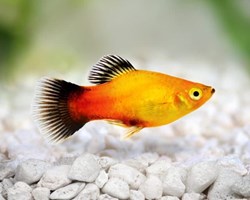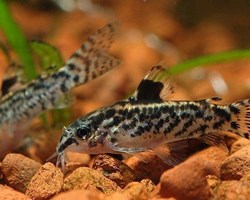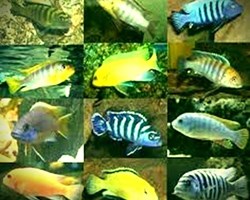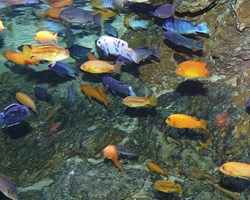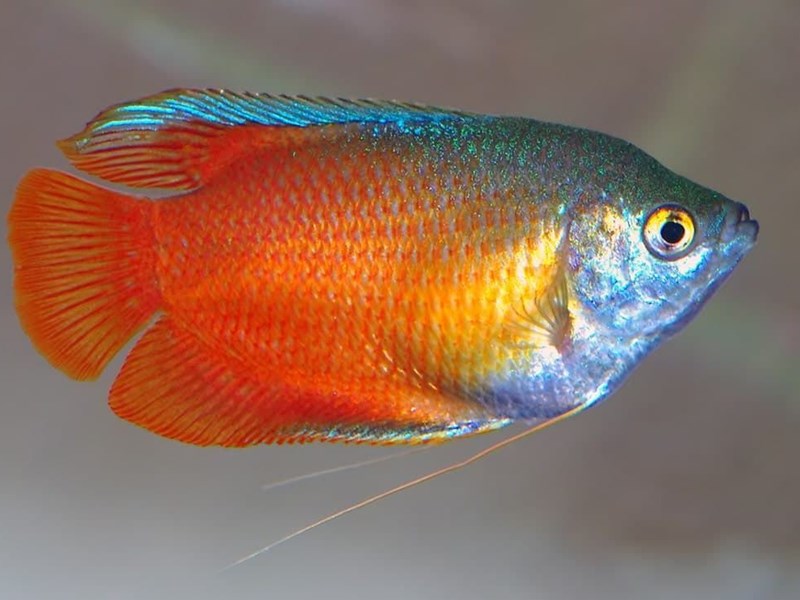
THREE-POINTED GURAMI: BLUE AND GOLD-ORANGE:
Although not as attractive as the Pearl or Dwarf Gouramis, the so-called three-point gouramis are the most resistant of all the Gouramis since they survive perfectly in any type of water and in a wide variety of maintenance conditions that include low temperatures and the presence of strong currents in the water.
They live in small groups made up of a single male and several females, always under thick blankets of floating plants or among dense mounds of submerged plants, also hanging around large logs or stones.
Like the rest of the Gouramis, the three-spotted one comes from Southeast Asia (Vietnam, Cambodia and Thailand especially), living in all kinds of waters although it prefers stagnant and quite murky ones.
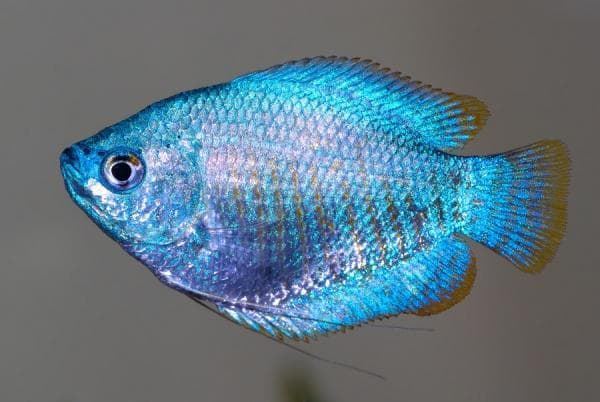
DESCRIPTION OF THE THREE-POINTED GURAMI: BLUE AND GOLD-ORANGE.
Their bodies are very compressed laterally, with short and not very thick fins and rather atrophied muscles, which shows that they are not used to moving excessively.
His mouth is superior and has tiny teeth with which they grind their food.
The dorsal fin is located almost in the middle of the body and is quite short and inconspicuous.

The pectoral fins are rounded, the caudal fin is slightly forked, resembling a heart, and the anal fin (going from the anus to the caudal peduncle) is the longest.
As a main characteristic (which they share with all the other Gouramis) we can mention the threadlike structure of the ventral fins, which function as auxiliary sensory organs in water that is too cloudy.
They also have, like the rest of the Labyrinthids, an additional lung that allows them to take in atmospheric oxygen directly.
Although they are commonly known as three-spot gouramis, in reality fish with these points are rarely seen for sale.
Artificial genetic selection has created two main varieties: The Cobalt Blue (blue body with some dark blue spots and fins with light blue dots) and the Gold (yellow body with some or no orange stripes and fins with yellow dots), mentioning the increasingly popular tiger (blue body with several parallel vertical stripes of navy blue that go from the snout to the caudal peduncle).
The wild ones are very light sky blue and have three black spots on each flank: one next to the operculum, another in the middle of the body and another on the caudal peduncle.
Sexual dimorphism, noticeable after five months of life, basically consists of the fact that the dorsal fin of the males is larger and more pointed than that of the females, the latter being smaller, with less vivid colors and with a bulging belly. They can measure up to 15 cm in length and live for more than 5 years.
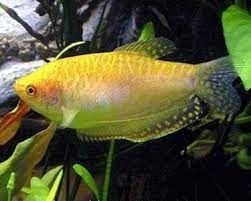
CARE OF THE THREE-POINTED GURAMI: BLUE AND GOLD-ORANGE:
It is the easiest gourami to keep in an aquarium due to its almost zero maintenance requirements.
An aquarium of 40 liters of water is enough for a single specimen, and it must be increased to 150 or 200 if you want to keep a single male with several females.
The decoration should be formed by large tangles of submerged plants in addition to many trunks, roots or stones that provide them with hiding places.
It is highly recommended to install floating plants (Lemna Minor, Pistia, Eicchornia Crassipes,...) so that they feel at home, as well as maintaining a rather dim light and a dark-colored substrate that enhances their libeans.
Although it is more beneficial to keep them in almost stagnant and very little oxygenated waters, they adapt without any problem to quite moving and aerated waters (also to very intense lights), even better than other popular species such as the Pearl Gourami.
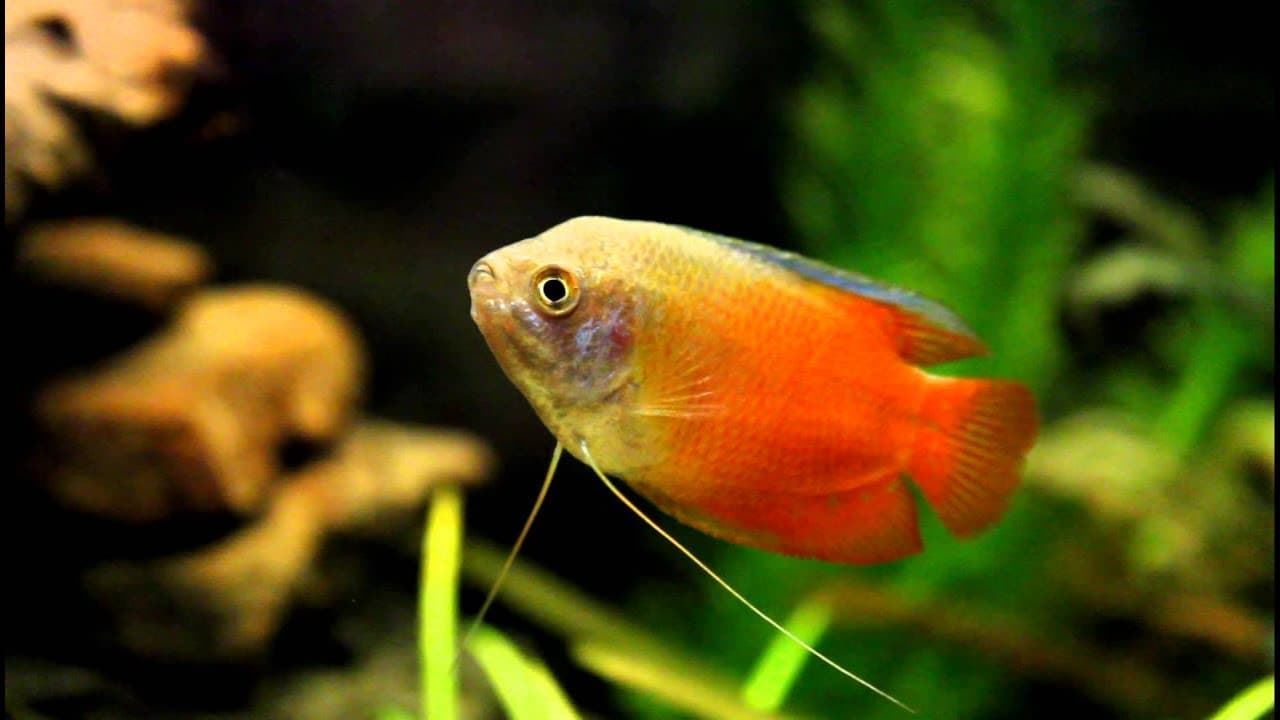
THE BEST AQUARIUM CONDITIONS FOR THE THREE-POINTED GURAMI:
It is advisable to keep them in acidic and soft waters (pH between 5 and 6.5 and hardness less than 10ºdGH) to increase their quality of life, living without any problem in much more alkaline and hard waters (pH up to 9 and hardness up to 50 °dGH).
It is highly advisable to filter through peat to keep the water soft and acidic.
The temperature can vary between 16 and 35 ºC (the optimum being between 24 and 28 ºC to avoid problems).
Nitrate levels must always be kept below 50 ppm, and nitrites and ammonia at 0 ppm.
Any excess of these pollutants eventually weakens their immune system causing them to be attacked by all kinds of diseases.
They are perfectly given to contracting the Gourami Iridiovirus but with much less ease than the Colisas, for example.
It can be said that it is very resistant to diseases of all kinds as long as they are kept in the right conditions and with non-existent sudden variations.
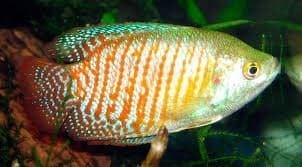
THE NUTRITION FOR THE THREE-POINTED GURAMI:
They do not present any problem feeding in captivity even during the acclimatization phase, being extremely fast and voracious when it comes to eating.
They unceremoniously accept flakes, granules, live, frozen and lyophilized, being very fond of insect larvae.
If they don't get enough plant matter, they may eat the soft leaves of aquatic plants.
Your ideal diet should be composed of low-bulk proteins (flakes, granules and generic frozen) and vegetables (flakes for herbivores, lettuce, algae, ...).
If they are very stressed, scared or sick, they can stop eating until they calm down.
Although in most cases the fish eat again, others are left to starve.
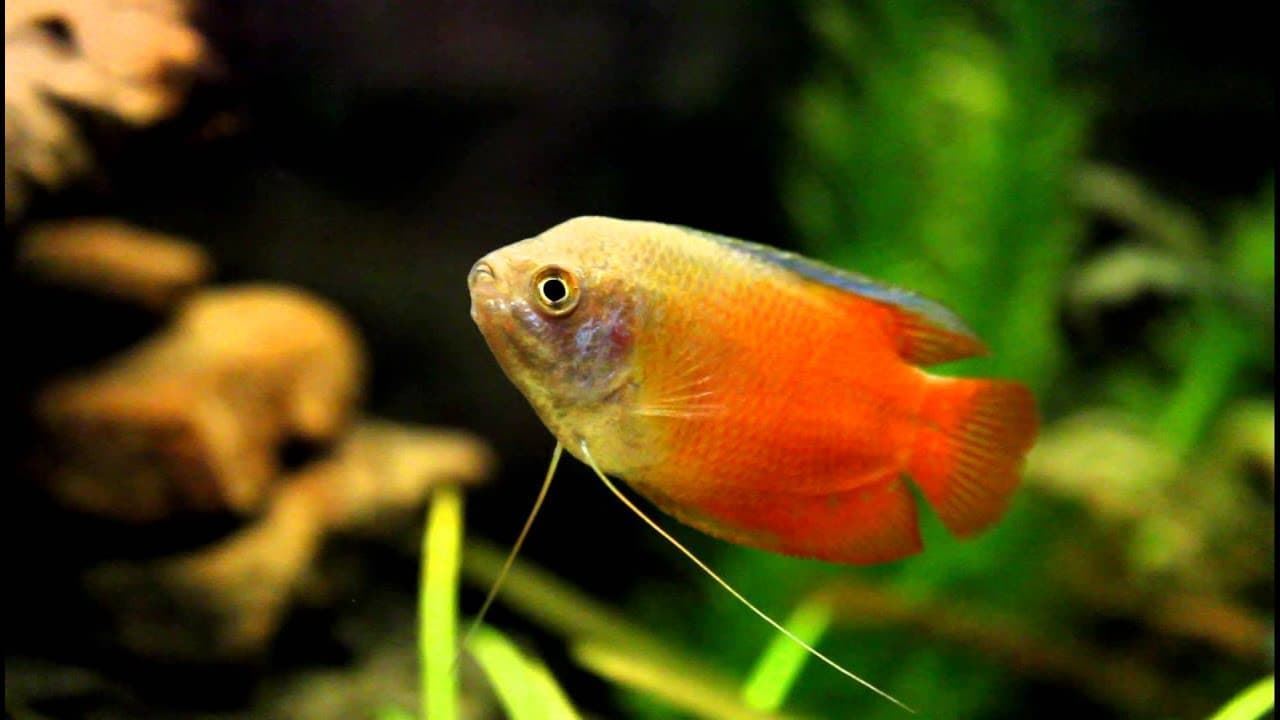

BEHAVIOR AND COMPATIBILITY OF THE THREE-POINTED GURAMI:
They are the most active and confident among the different Guramis (in addition to being one of the most aggressive), adapting perfectly to coexistence with a large number of species.
It is not advisable, however, to mix them with fish that are too fast, such as Zebritas, which can leave them without food, fin-biters, such as many Barbels, which destroy their long ventral fins, too large or temperamental cichlids, such as Firemouths or Convicts, who intimidate them and other labyrinths like Bettas to avoid brutal fights for dominance of territory.
Never bring together more than one male in the same aquarium to prevent them from fighting to the death.
Their aggressiveness grows as they become adults, at which point some specimens become a real nuisance for fish that are too small, which they constantly chase, even biting the fins of other fish of the same or larger size.
Others go wildly from all their companions throughout their lives and others join them to live together in peace.
It is not recommended to keep a single female with a male to avoid being constantly harassed.
They can be associated with fish of not excessively small size (Neons, Harlequins, Red Ghost Tetras and the like), bottom fish such as Ancistrus, Plecostomos and Otocinclos and some calm surface fish such as Axefish.
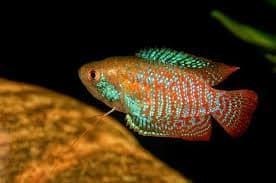
THE REPRODUCTION OF THE THREE-POINTED GURAMI:
It is quite easy to breed them in captivity as long as certain conditions are met.
The breeding pair must be kept in a breeding aquarium of about 40 liters, specific, abundantly decorated with trunks and dense plastic fibers, very acidic and soft water (pH between 5 and 6 and hardness less than 5ºdGH) and, especially, a generous bed of floating plants of any kind.
The temperature should be kept between 26 and 28 ºC.
It is highly advisable to separate the male from the female for a few days to prevent him from killing her (a glass partition in the middle of the aquarium is sufficient).
During this time the future parents must be fed with abundant live prey.
When the male builds a bubble nest and the female, her belly greatly swollen, follows him across the divide, it means they are ready to spawn.
Courtship, somewhat violent, ends under the bubble nest built by the male.
The female expels up to 150 eggs, which are fertilized and transferred to the nest by the male.
Once spawning is finished, the male is in charge of guarding his precious eggs alone, killing any intruder that gets too close (even the female, who must be removed to avoid it). Hatching occurs two days after spawning, and the male remains with his young until they exhaust the yolk sac. Once they have reabsorbed it, the male must be removed to prevent it from devouring the fry.
These can be fed micronutrients (suspension preparations or Infusoria) and grow quite quickly.
It is necessary to cover the aquarium very well to avoid any excessive difference in temperature between the water and the surface air, a problem that is fatal for the fry as the labyrinth is still developing.
They are not very sensitive to high concentrations of nitrate (never above 30 ppm) but they are to sudden variations in aquatic parameters, especially temperature.

